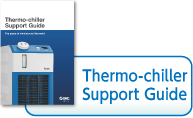Temperature Control Equipment

●Electrical conductivity
A value indicating the ease with which electricity passes through a liquid, and is inversely proportional to the specific resistance. The unit used is [S/m], incorporating [S] (Siemens), the opposite of [Ω] (resistance).
At 25°C, the electrical conductivity of theoretically 100% deionized water is 0.055 [μS/m].
●Electromagnetic contactor
An electric device for turning power circuits ON/OFF to start and stop power equipment (e.g. motors, heaters). Just like a relay, these devices open or close a mechanical contact with the power of a solenoid. The principle of operation is the same as a relay, but a contactor is designed for high-voltage and large current.
●Electromagnetic switch
A device integrating an electromagnetic contactor with a thermal relay.
●EMO circuit
An EMO (EMergency Off) circuit is an electrical circuit provided to shut off all power and ensure safe conditions when an emergency stop button (EMO button) is pressed in an emergency.
●Ethylene glycol aqueous solution
Ethylene glycol is a type of alcohol, and adding it to water causes the freezing point of the water to drop. It is a major ingredient in antifreeze for automobiles. At a concentration of 60%, the freezing point drops to –40°C or lower, but the viscosity increases as the temperature drops, so taking fluidity into account, it is practical to consider about –20°C as the minimum temperature.
By adding ethylene glycol to deionized water, it is possible to raise the fluid’s specific resistance, so it can be used for applications where circulating fluid with high insulating properties is desired.
●ETL mark
Intertek ETL SEMKO is an NRTL, and issues the ETL mark.
This mark demonstrates compliance with UL standards.
●Evaporator
A heat exchanger used to cool the target substance (e.g., water or air) using the evaporative heat from a low-temperature, low-pressure combined gaseous and liquid refrigerant in the refrigeration circuit.
●Expansion valve
A component that creates an expansion in the refrigeration circuit. As the refrigerant passes through this valve, a large pressure loss results, thereby making it possible to create high-pressure and low-pressure segments within the refrigeration circuit.
There are several types of expansion valve, including constant-pressure expansion valves and thermal expansion valves. Such types allow the size of the valve aperture to be adjusted using refrigerant pressure or temperature feedback from an outlet passage.
●External sensor
Temperature sensor mounted to the outside of temperature control equipment and used for learning control etc.
▲Page Top

















